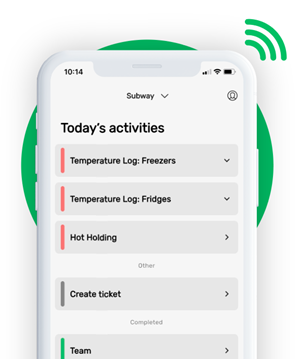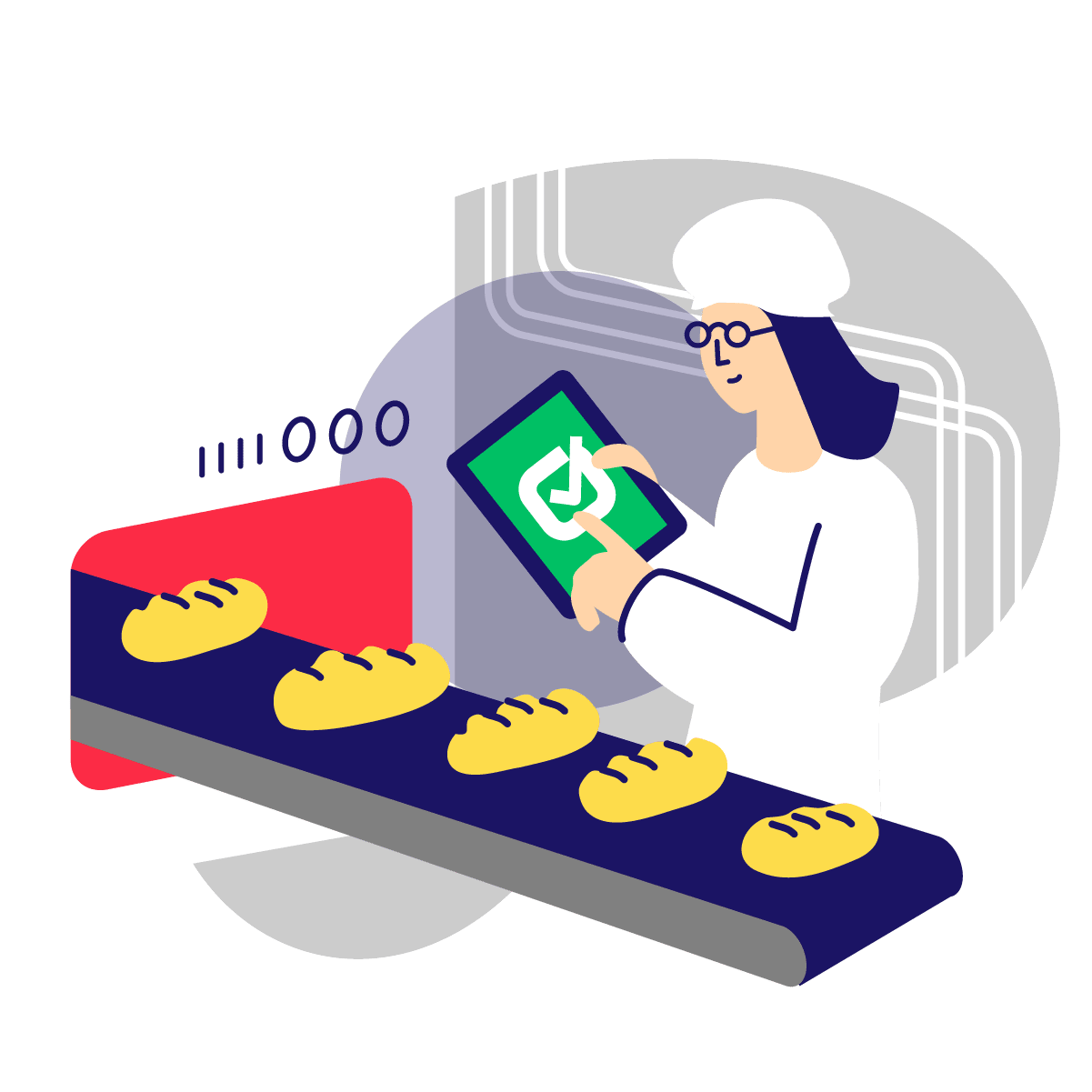Restaurant Steps of Service: 7 Keys to Exceptional Dining Experiences
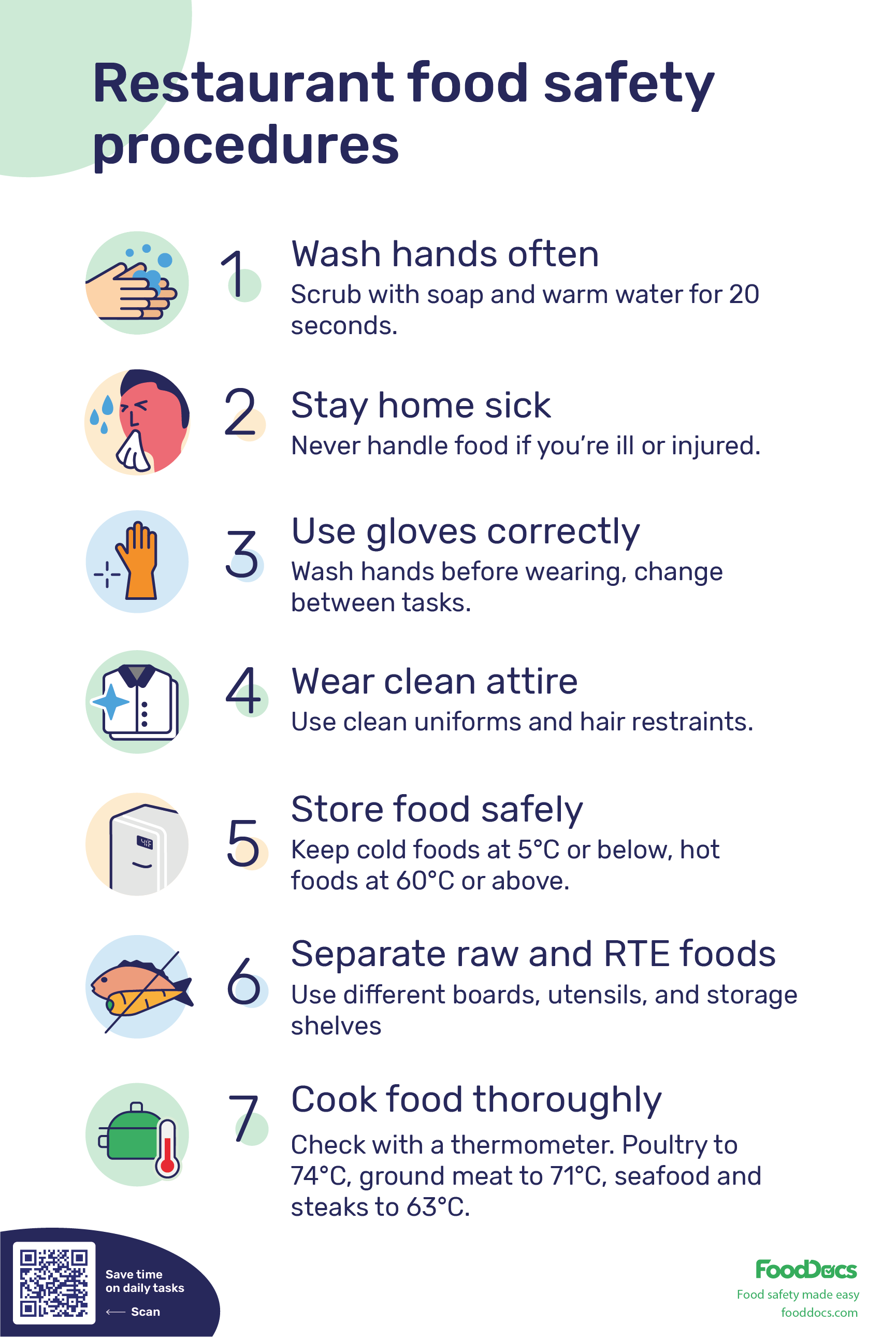



This is how our Digital Food Safety platform saves 20% of your time on daily tasks:
- Get upcoming task notifications
- Add data into the app
- Check the status of tasks in real-time

When food safety was still handled on paper, I typically spent a couple of hours per day getting the papers and going around checking or completing tasks… Now I can sit down and it's just all there in one place. It takes me 5-10 minutes.
Ruth B.
Store Manager
One of the biggest challenges for any restaurant management lead is ensuring that every staff member follows the service rules 100 percent of the time. In a busy, high-level restaurant, even one slip (e.g., a missed greeting, a late check-back, or a forgotten farewell) can throw off the entire guest experience.
That’s where restaurant steps of service come in. They’re the standard sequence of actions your team follows from the moment a guest walks in until they leave. Done well, they guarantee consistency, professionalism, and the kind of dining experience guests come back for.
When your staff masters these steps, you don’t just get smoother shifts. You get:
- Happier guests
- Stronger reviews
- Repeat business that fuels growth
In this guide, we’ll walk through the 7 steps of service in a restaurant, highlight what changes in fine dining, and share how to train your team to execute each step flawlessly.
We’ll also show how the FoodDocs app can help your team stay on top of all the needed service and safety rules — saving you up to an hour every day on supervision (per location).
Download our free ebook


Thank you for downloading ebook!
Want to get a customizable HACCP template?
Or set up your food safety system in 15 minutes?
With the right structure and tools in place, it becomes easier to keep service consistent across every shift while also strengthening your food safety practices.
Key takeaways
-
Restaurant steps of service are the foundation of consistent dining experiences.
-
Clear service steps directly impact guest satisfaction and repeat business.
-
The seven core steps of service are welcome, orders, delivery, check-ins, dessert, check, and reset.
-
Fine dining restaurants add extra polish and precision to these core steps.
-
Common mistakes like slow greetings or delayed bills damage customer satisfaction.
-
Server training with manuals, role-play, and mentorship makes service steps second nature.
-
Checklists, SOPs, and digital tools provide consistency across shifts.
-
FoodDocs software reinforces service with instructions, SOPs, and digital checklists.
-
Smart automation and notifications give managers better oversight with less micromanagement.
-
Blending service steps with food safety builds trust and efficiency for guests and staff.
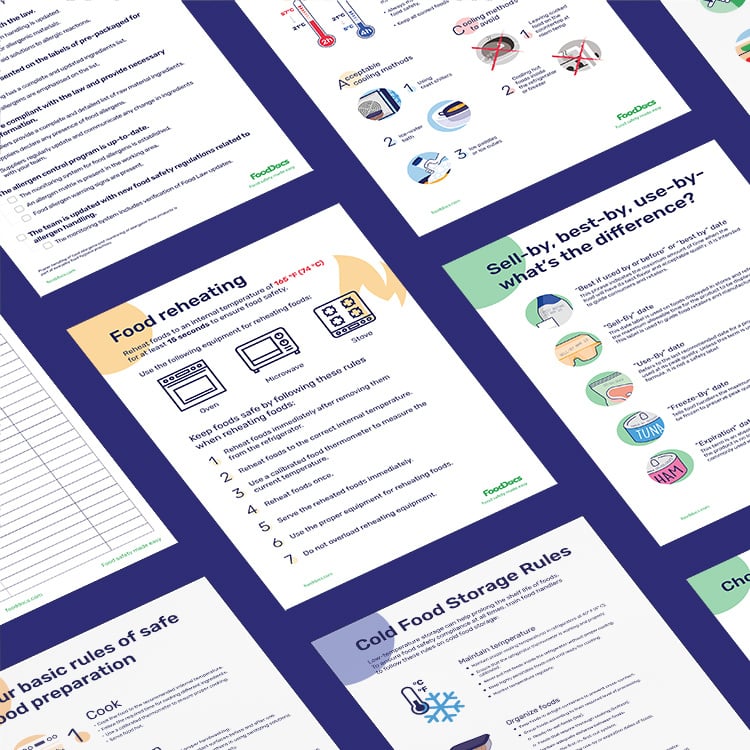
Get our most popular restaurant management resources
What are the steps of service in a restaurant?
The steps of service in a restaurant are the key touchpoints of a guest’s dining experience, from greeting the customer to saying goodbye. They cover everything your staff does to take care of guests, including seating them, taking orders, serving food, checking on their needs, and handling the bill.
Each step is there to make guests feel welcome, attended to, and satisfied with their visit. By following a clear sequence, your team can deliver a consistently great experience every time, rather than leaving service quality up to individual style or memory.
Research has shown that a huge part of satisfied customer experiences comes down to just a few simple service factors:
- How quickly guests are greeted
- Whether their drinks stay full
- How promptly they receive the check.
That’s why mastering the basics matters.
Defining your restaurant’s specific steps of service is a foundation part of running a food business, be it a casual café, sports bar, or fine dining establishment. It creates a standard playbook for your waitstaff and hosts.
New hires learn what’s expected, and regular staff have a refresher to stay consistent. Many restaurants even post a checklist or create a handy PDF guide (like the free Restaurant Steps of Service PDF we offer) so everyone can quickly review the sequence of tasks.
Why do the steps of service matter in a restaurant?
Clear steps of service are more than a checklist. They directly impact your restaurant’s bottom line. When guests feel welcomed and looked after, they’re more likely to return and leave positive reviews. Consistent service also drives higher sales.
For example, servers who always follow the step of offering dessert or after-dinner drinks consistently increase the average check size.
On the operations side, steps of service reduce errors and training time. New hires know exactly what to do from day one, and experienced staff have a framework to keep service consistent across shifts. That consistency lowers stress, improves staff confidence, and makes the dining experience smoother for everyone.
Steps of service create happier guests, more efficient teams, and stronger business performance.
What are the 7 restaurant steps of service?
Every restaurant may tweak the details, but generally, the seven steps of service cover the entire guest journey. Here are the 7 essential steps of service in a restaurant, and what each one involves:

1. Warm welcome and seating
First impressions are everything. Greet guests with a friendly smile the moment they arrive, and seat them promptly at a clean, prepared table. Make them feel valued and comfortable right away (offer to take coats or adjust the seating if needed).
This warm welcome shows your restaurant’s hospitality from the start and sets a positive tone for the meal. And as you'll see in the Real Server Training video below, Patrick Murphy gives you a POV experience of what a great table-greeting looks like:
2. Taking orders efficiently
Once guests are settled, the next step is to take their orders accurately and efficiently. Approach the table with a smile (and perhaps a notepad or tablet) and be ready to answer questions about the menu. Listen carefully, note any special requests or dietary needs, and repeat the order back to confirm everything is correct.
A knowledgeable, attentive server here makes guests feel confident that they’ll get exactly what they want.
3. Delivering food and beverages
This step is all about timely, proper delivery of drinks and dishes. Serve beverages and appetizers promptly, and ensure each course arrives at the right time. Nobody should get their main course while others are still on appetizers.
Pay attention to presentation and any special instructions (like food allergies or extra sauces) when delivering plates. A smooth delivery of food and drinks keeps the experience on track and shows professionalism.
4. Checking in and table maintenance
A few minutes after the food is delivered (often the “two-bite” or two-minute rule), check in with the table. Ask if everything is delicious or if they need anything else. This is a chance to fix any issues (maybe they need an extra napkin or the steak isn’t cooked right). Just be attentive without hovering.
Table maintenance is part of this step too – refill water glasses or drinks, clear empty plates, and keep the table tidy as the meal progresses. Great servers balance being available with giving guests space to enjoy their meal.
5. Dessert and after-dinner service
Once main courses are done and cleared, offer dessert, coffee, or after-dinner drinks. Present the dessert menu or verbally suggest popular desserts. This is an opportunity to surprise and delight guests (who doesn’t love a great dessert recommendation?).
Time the dessert service so guests have a moment to rest after their entrées. When serving dessert or coffee, maintain the same level of care – a beautiful presentation, correct utensils, and checking if guests have everything they need to finish their meal happily.
6. Presenting the check and farewell
When you sense the guests are ready (plates are pushed away, or they ask for the bill), promptly present the check. In a more upscale setting, you might deliver it discreetly in a check presenter; in casual places, a simple check on a tray works. Process the payment quickly and accurately because no one enjoys waiting ages to pay.
Finally, thank the guests sincerely for coming and invite them to return. A warm goodbye (“Thank you, we hope to see you again soon!”) leaves a lasting positive impression as they exit.
7. Post-service tasks (cleaning and resetting the table)
The service isn’t truly over until the table is ready for the next guest. After customers leave, clear and clean the table thoroughly and reset it with fresh linens, dishes, and utensils for the next party.
This step also includes any behind-the-scenes wrap-up which includes:
- Inputting any notes about the guests (e.g., food allergy management or special occasions for next time)
- Reviewing feedback (i.e., seeing if the overall sentiment is positive, neutral, or negative)
A quick cleanup turnaround keeps your restaurant presentable and shows attention to detail even after the guests are gone.

These seven steps cover the full cycle of service, from greeting to resetting. When executed consistently, they ensure that every guest enjoys a smooth, pleasant experience. Of course, not every meal follows the script exactly.
Unexpected things can happen (e.g., a delay in the kitchen, a special guest request, etc.). But having these steps as a guideline helps your staff know how to respond and keeps service on track even when there are hiccups.
What are the most common mistakes to avoid during the restaurant sequence of service?
Even with a clear playbook, restaurants sometimes slip up on the basics. Here are the most common mistakes to watch for:
- Inconsistent greetings: Letting guests wait too long for a welcome sets the wrong tone from the start
- Skipping the check-back: If servers don’t return shortly after food is served, small issues go unnoticed until they become big complaints
- Delaying the bill: Guests consistently report that waiting too long for the check is one of their biggest frustrations
- Overloading new staff: Without support or clear guidance, new hires may cut corners or form habits that hurt consistency
- Ignoring updates to SOPs: If your steps of service aren’t reviewed and refreshed, staff may improvise in ways that drift from your standards
The key is catching these pitfalls early. Regular training, clear SOPs, and simple reminders help your team avoid these mistakes and keep service smooth from start to finish. As Henry Ford once said:
“The only thing worse than training your employees and having them leave is not training them and having them stay.”
What’s the difference between restaurant and fine dining steps of service?
Now, what about the fine dining steps of service? In an upscale or fine dining restaurant, the core steps are the same but with extra polish and detail at each stage.
Fine dining establishments often have more formalized service rituals to elevate the guest experience. For example:
- In Step 1 (Warm welcome and seating), fine dining restaurant servers might pull out chairs for guests or escort them arm-in-arm to the table
- During ordering, staff might offer detailed descriptions of dishes or help with wine pairings
- When delivering food, you may see synchronized service (multiple servers bringing plates so that everyone is served at the exact same time) and formal cloches or plate covers lifted in unison
- Table maintenance can include crumbing the table between courses and replacing utensils for each course
- The farewell in fine dining can be more elaborate, too, and have staff help guests with their coats and personally thank them by name
The key difference in fine dining service etiquette is the level of precision, personalization, and attention to detail. The sequence of service is executed with quiet professionalism and often a bit of ceremony. Offering an amuse-bouche before the meal or a palate cleanser sorbet between courses, for example, are extra steps typically found in fine dining.

However, the fundamental goals remain the same: make the guest feel welcome, well-served, and special throughout their visit. If you run a fine dining restaurant, it’s important to train your team on these additional touches (on top of the basic seven steps).
Guests paying premium prices expect a flawless service sequence, so consistency here is non-negotiable.
How to train your team on the steps of service in a restaurant (6 practical steps)
Having a list of steps isn’t enough. You must make sure your staff follow them every time. Training is where the magic happens.

Here are six tips for turning the theory of steps of service into everyday practice on your restaurant floor:
Provide a structured training program
Don’t just hand new employees a list – walk them through each step. Many restaurants create a training manual or guide that details each step of service (this is where your free “Restaurant Steps of Service” PDF comes in handy as a cheat sheet). Go over the why and how of each step.
Explain why greeting guests within 30 seconds is so important, for example, or how checking back after a couple of bites can catch any issues early. Include role-playing exercises: one person plays the guest, another the server, and walk through a full meal scenario.
This hands-on practice builds confidence and muscle memory.
Use mentorship and shadowing
Pair up new servers with your best, most experienced servers for a few shifts. Let the newcomers shadow and observe how the veterans greet tables, handle orders, and so on. A mentorship system helps new staff pick up on the little details that aren’t always written down.
It also reinforces your restaurant’s specific style of service. Encourage experienced staff to share tips and feedback with the new hires after each shift.
Emphasize customer service at every step
Make sure your team understands why each step matters for the guest. For instance, if a server forgets to offer dessert or coffee (Step 5), the restaurant could lose out on sales, and the guest might feel less cared for. Or if the check isn’t brought promptly (Step 6), an otherwise great meal could end on a sour note of frustration.
Tie each step back to customer satisfaction and the restaurant’s brand reputation management. When staff take pride in service quality, they’re more likely to follow through consistently.
Create checklists and use tools for consistency
It can help to provide physical or digital checklists of daily service tasks. Some restaurants pin a small checklist to the server station as a reminder (e.g., “1. Greet within 30s, 2. Offer water, 3. Serve drinks within 3 min,” etc.).
An even better approach is using different types of restaurant management software to your advantage. For example, FoodDocs offers a digital platform where you can create daily monitoring tasks and attach clear instructions or media to each task.
You can set up your own “review service steps” checklist in the system, complete with photos or short videos demonstrating how to perform certain tasks. Each staff member would see these tasks on their phone or tablet, ensuring they don’t skip steps.
The educative instructions feature lets you include training material right into the workflow (for instance, an image showing the proper table setting or a video on how to open wine correctly). This way, your team has a training reference at their fingertips during service, which saves you time on coaching and prevents mistakes.
Standardize your SOPs
Your Standard Operating Procedures (SOPs) for service should be documented and easily accessible. The steps of service are an SOP for front-of-house service. Keep these SOPs updated and review them periodically with the team.
Using a digital food safety management system like FoodDocs can also help here by being a place you can digitally store a steps of service document.
FoodDocs also auto-generates and stores various SOP templates for your business, including cleaning procedures to opening and closing protocols). You can customize these SOPs and have them ready for download or reference anytime, which is great for training refreshers and onboarding new hires.
When everyone is following the same playbook, you’ll see more consistent performance across different shifts and staff.
Continuous improvement
Training isn’t a one-and-done thing. Conduct brief refreshers or “spot training” sessions during staff meetings. Maybe once a month, pick one step of service to focus on (e.g., practice upselling desserts, or work on faster table resets). Encourage your team to share experiences: “What’s something you do to wow guests during the welcome?” or “How do you handle it if an entrée is delayed?”
These discussions can surface great tips and identify areas to improve. Also, consider collecting feedback from customers (e.g., comment cards or online reviews) and sharing any service compliments or issues with the team. For example, if multiple reviews mention slow check delivery, you know to reinforce Step 6 in training.
When you invest time in training and using smart tools, you create a culture where excellent service is second nature. Your staff will feel more confident and prepared, which reduces stress during busy rushes and leads to happier guests.
Why should I use FoodDocs to maintain service and safety standards?
Running a restaurant means juggling both customer service and food safety duties every day. This is where technology like FoodDocs’ restaurant food safety software can be a game-changer for busy restaurant managers.
It’s designed to streamline all those routine tasks and checks that keep your restaurant running safely and smoothly – and it turns out, it can help with training and service consistency as well.
Here’s how you can leverage FoodDocs (and similar digital tools) to support your steps of service and overall operations:
Consistency through SOPs and checklists
As a Restaurant Manager, one of the most important SOP should be seven teps of service checklist. When standard operating procedures all live in a centralized place, staff can keep all relevant tasks in mind more easily.
FoodDocs automatically generates Standard Operating Procedure templates for common processes in your food business. While many SOPs are food-safety related (like sanitation and cleaning, allergen control, etc.), having all these procedures documented in one place ensures your back-of-house is running just as consistently as your front-of-house service.
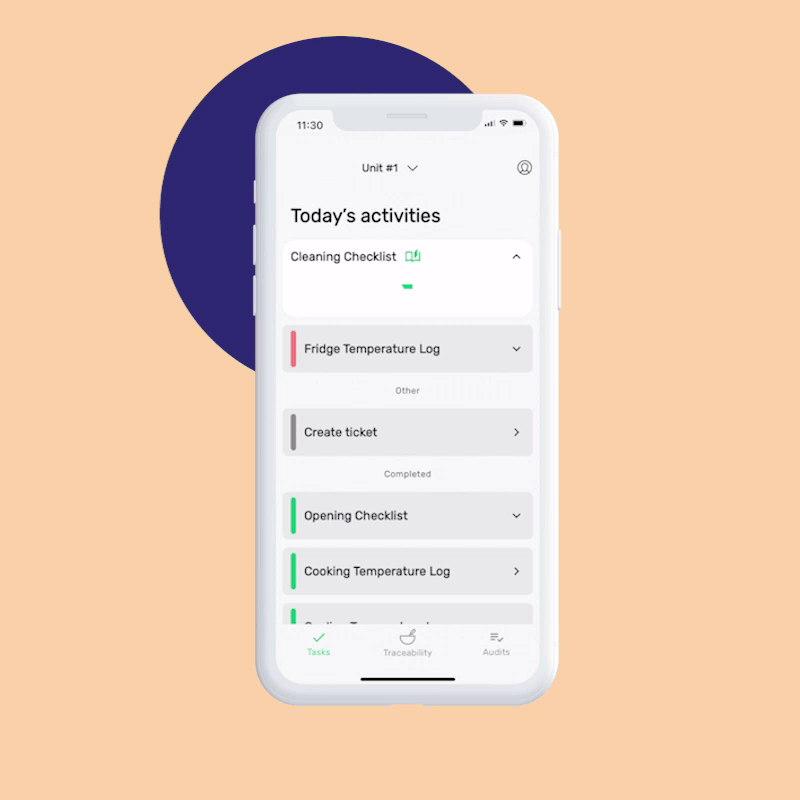
You can easily customize the SOPs to include any specific service protocols you have. Because the system is digital and cloud-based, any update you make to a procedure or checklist is instantly available to the whole team. That means everyone always refers to the current method of doing things. No outdated print-outs, no excuses.
Built-in training instructions
As mentioned earlier, FoodDocs lets you attach educational instructions (photos, videos, or text) to any monitoring task. While many of these tasks will be kitchen-focused (like checking fridge temperatures or cleaning schedules), you can also use it for front-of-house tasks.

For example, you could create a daily task for “Dining room prep” and attach a photo of the perfect table setup for reference. Or add an instructional video for “How to properly greet and seat guests” to a host’s daily checklist.
New or forgetful staff can quickly check these guidelines on their phone while doing the task. This feature basically bakes training into everyday work, so your team learns by doing with a safety net if they’re unsure how to do something correctly.
Saving time on supervision
With smart software handling routine logs and reminders, you free up time to focus on coaching your team and observing the guest experience in real time. FoodDocs can send automatic notifications and alerts to staff for their tasks. For example, a ping if a temperature check was missed, or a reminder to do the restroom check.
Managers also get a real-time dashboard to see if all tasks (safety checks and any service-related checks you’ve added) are completed each day. This level of oversight helps catch issues before they become bigger problems. In essence, the software acts like a personal assistant, so you don’t have to micromanage every little detail.
You can trust that critical things are getting done, and spend more time training staff or giving guests a memorable experience.
Food safety and service go hand-in-hand
Alongside giving guests a great dining experience, restaurants must build trust that the food is safe and the environment is clean. When you use a tool like FoodDocs to stay on top of food safety monitoring (e.g., logging cooking temperatures, cooling times, cleaning tasks, etc.), you ensure that behind the scenes, your kitchen is operating safely and efficiently.
This definitely matters to your guests, even if they don’t see it directly. When your staff isn’t scrambling to remember if they checked the fridge or if the sanitizer bucket is out, they can give more attention to the people in front of them. Digital food safety management reduces human error and stress, which indirectly improves front-of-house service too. It’s all connected.
Embracing a digital solution such as FoodDocs can help you maintain high standards consistently. Your team gets the guidance they need through built-in instructions and SOPs, and you get peace of mind knowing both service and safety tasks are handled properly each day. It’s like having an extra manager on duty, ensuring service runs as smoothly as possible, night after night.
Ready to revamp your approach to the restaurant steps of service?
Mastering these restaurant steps of service can truly set your restaurant apart. When every server knows to greet warmly, check back at just the right times, and leave guests with a fantastic final impression, you create experiences that diners remember.
The payoff is happier customers, better reviews, and a growing base of regulars who trust your restaurant for both great food and great service.
But knowledge alone won’t spark change. Action will. So here’s what to do next: Start by downloading our free “Restaurant Steps of Service” PDF guide. It’s a handy reference you can use to train your team or even post in the back-of-house as a daily reminder.
Go through the checklist with your staff, gather their input, and make sure everyone’s clear on each step. Consistency is key, so make those steps of service a routine part of how you operate.
Finally, consider how you can support your team with the right tools. If you’re looking for a smarter way to keep everyone on track (and save yourself time), give FoodDocs a try with a 14-day free trial. Our food safety management software can double as a training and task management tool to help reinforce those service steps and handle your food safety checks all in one place.
Frequently asked questions about the steps of service in a restaurant
What timing benchmarks should you target at each step of service?
Set clear time goals so service feels smooth and predictable.
- Greet within 30 seconds. Offer water within 1 minute.
- Take drink orders within 2 minutes. Serve non alcoholic drinks within 3 minutes. Alcohol within 5 minutes.
- Take food order within 8 minutes of seating or sooner if ready.
- Appetizers within 10 minutes. Entrées within 15 to 20 minutes.
- First check back at 2 minutes or two bites.
- Dessert menu within 3 minutes of clearing entrées.
- Present the check within 2 minutes of the ask. Process payment within 3 minutes.
- Reset the table within 3 minutes of the guests leaving.
How should you handle allergens within the food service sequence?
Ask early and record clearly to handle allergens properly and confirm again before sending the order. Here are some tips:
- Ask about allergies when taking the order; repeat the allergy back in simple words
- Mark the ticket for the kitchen; confirm the allergen with the expo.
- Deliver the plate with a clear verbal confirmation
- Use FoodDocs to attach a short allergen SOP and a visual cross-contact guide to the daily service checklist so new staff can review on shift
Can you adapt the seven steps of service for takeout and delivery?
Yes, you can adapt the restaurant's steps of service for takeout and delivery. Use the same intent with shorter touchpoints:
- Warm welcome becomes a fast and friendly pickup handoff.
- Verify name and order accuracy out loud.
- Offer napkins, utensils, and sauces without being asked.
- Confirm delivery instructions and timing when phones ring.
- Close with a thank you and an invite to review or return.
- Track a simple pickup checklist so bags, seals, and temperature checks do not get missed.
What does a five-minute pre-shift brief look like?
A short and useful, five-minute pre-shift brief can look like this:
- First minute: Today’s cover count, reservations, menu specials, and 86'd items
- Second minute: Menu highlight and two upsell suggestions
- Third minute: Service focus for the shift. For example, greet within 30 seconds or dessert attach rate
- Fourth minute: Safety note. For example, allergen cross-contact or sanitizer checks
- Fifth minute: Quick role play of the focus item
How can you recover from kitchen delays or mistakes without losing the table?
If you want to recover from kitchen delays or mistakes without losing the table, own it fast, offer options, and follow up. Here five some practical tips:
- Acknowledge the delay before the guest asks
- Give a clear time update and one choice. For example, wait two minutes or fire an alternative
- Offer a small gesture within policy. For example, coffee or dessert recommendation later
- Return in two minutes with an update
- Add a short script to your service SOP in FoodDocs so new servers have the words
How do you prevent bottlenecks at the check step?
To prevent bottlenecks at the check step, set up the close earlier and remove friction. Do things like:
- Drop the dessert menu and quietly ask if the guest would like the check ready
- Pre-split checks when the table signals up front
- Use handheld payment where possible
- Check back within two minutes if the check sits unopened
- Make a tiny check step checklist in FoodDocs so new hires learn the rhythm
How should you coach suggestive selling that feels natural?
Lead with value and make it personal if you want suggestive selling during service to feel natural. For example, try to:
- Recommend one item by name with a quick reason. For example, our lemon tart is bright and not too sweet
- Offer a pairing that fits the meal or season
- Suggest one small bite for the table if they say they are full
- Track dessert attach rate and share a daily win in the pre-shift brief
How do you measure and improve service over time?
You can measure and improve service over time by picking a few metrics and reviewing them every week. For example:
- Greeting time, check back time, dessert attach rate, table turn time, and check delivery to payment time
- Pull POS system reports for attach rates and turn times
- Scan reviews weekly for trends
- Log completion of service tasks in FoodDocs and note misses
- Share wins and one focus in the pre-shift brief so the loop stays tight
How should you onboard a new server in seven days?
You should onboard a new server in seven days by providing them with structure and time to practice. For example, on:
- Day 1: Orientation, menu tour, and shadow.
- Day 2: Sections one and two with trainer backup. Focus on greetings and drinks.
- Day 3: Sections three and four. Focus on order accuracy and allergen asks.
- Day 4: Sections five and six. Focus on the course timing and check the step.
- Day 5: Full section with trainer as support only.
- Day 6: Solo with manager spot checks and a short quiz stored in FoodDocs.
- Day 7: Review metrics and sign off on SOPs.
